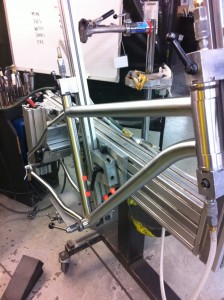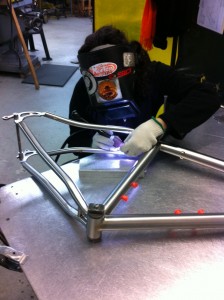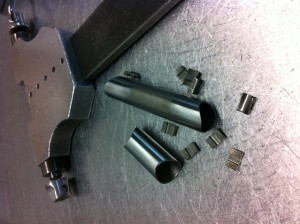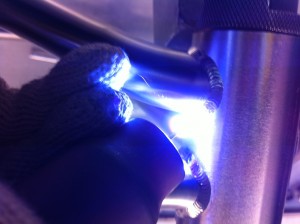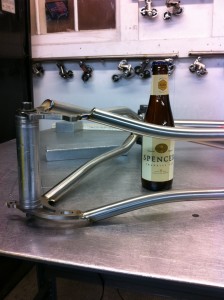Nestled snug in their box, the tubes that will become my frame roll, with the jig, from machining to welding, where they wait to be claimed. Who welds each frame is a matter of chance. Whichever welder is available at the moment takes the next frame in line. In my case, that welder is Stef Adams. Coincidentally, Stef welded my other Seven back in 2005, an Elium SL, and she did such a good job with that one that my thirst for a new bike was stifled for nearly a decade.
While in the machining stage, tubes get coated with grease, dust, shavings, “permanent”marker, finger prints, oil, and who knows what else. To ensure that her welds will last a lifetime, Stef cleans each tube in a two stage acetone bath which wipes away everything, including the boastful claims of the marker. By wearing fresh, cotton gloves she keeps her own finger prints off the tubes in the process.
Sevens are TIG welded (the acronym stands for Tungsten Inert Gas). We pump argon through our frame jigs and into the tube sets as we weld them. The inert argon won’t react with the molten titanium, which is why we use it to “clean” the inside and outside of each area to be welded.
Stef assembles the clean tubes back into the jig, then hooks up a gasket to the head tube in order to create the back purge, plugging all of the external holes in the frame (e.g. where water bottles will be mounted) with stoppers. Internal breather holes, previously drilled into the tubes, will allow the gas to flow from one tube to the next until all of the tubes are overflowing with argon. Argon also flows out of the welder’s torch which protects the outside of the tubes.
A gauge at each welding station lets the welders know when there is enough argon in the frame to begin welding. Stef checks the gauge and begins tacking one tube to the next. A tack is a small spot weld that holds the tubes in place. They make freehand welding more manageable.
Out of the jig and onto the welding table the tacked frame goes. Stef works in a most graceful fashion, twirling the frame around the table, welding a little here, a little there, with the smooth, precise movements that she has perfected over the course of more than seven thousand frames.
Little by little, the frame gets closer to completion. Stef says it takes a few hours to weld a frame as “simple” as mine, but that couplers and other options can add to that. My frame is simple in that it is a straight forward mountain bike, with no additional features or options that need to be welded on. I clarify with her that it is also awesome, and she agrees.
Below are the bridges and zip tie guides. Not too many, means not too complicated.
Perfectly round, overlapping droplets of molten titanium bond the tubes together. A stack of dimes, fish scales, whatever you want to call them, they will hold the frame together for the rest of its life. I think they are beautiful. One of the many artistic achievements of the welder is to make it appear that the weld was done all at once, one droplet after the next, until the entire tube is welded, but in reality, they work in tiny centimeter long increments, which is why the frame is flipped, spun, and maneuvered into different positions as they go.
For a novice, welding can be pretty scary. There is electricity, intense heat, and a light so bright it could blind you. Behind a camera lens, it looks like a brilliant purple and blue light.
But from behind the welder’s mask, it’s actually quite pleasing. The welding mask is tinted so dark that, to Stef, it feels like welding by candle light. She works slowly but steadily. Aiming the torch with her right hand, she increases the heat until it’s so hot that the spindly titanium bead in her left hand melts when she dabs it on the tube. Each droplet adds material and strength to the weld. This style of welding bikes is called the Puddle Bead Method, and was pioneered by another welder at Seven, Tim Delaney. Stef is a master, and does a great job of explaining what she is doing while she works. She makes it look so easy, but I know that if I were at the helm, there would be shouting, catastrophe, and probably a fire.
A job well done and a small token of appreciation.
The next time I check on it, the frame is all together and hanging up in the final machining department, ready for the next steps, so close to completion.

